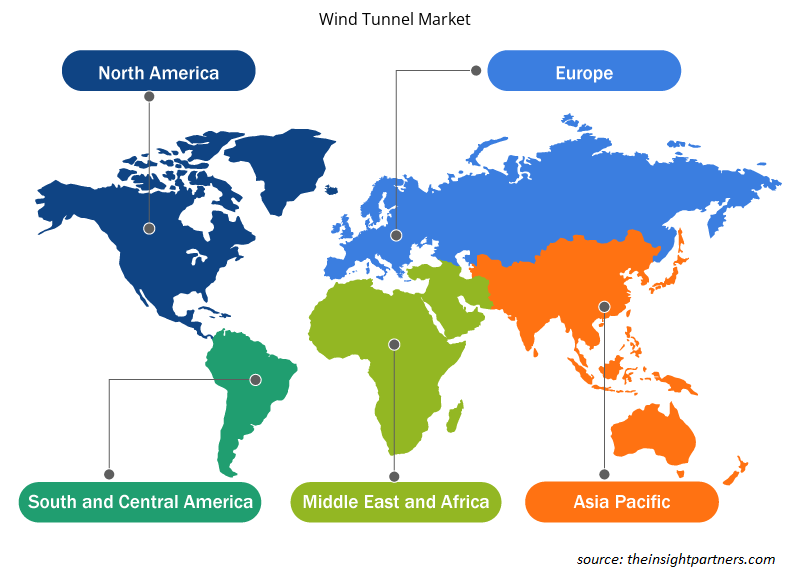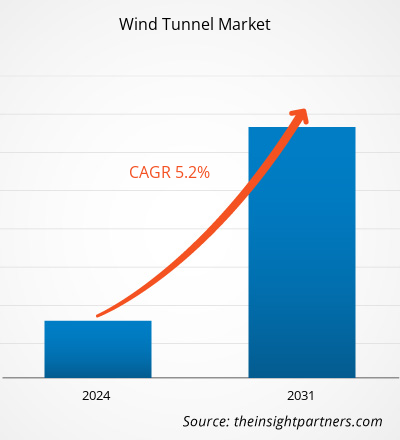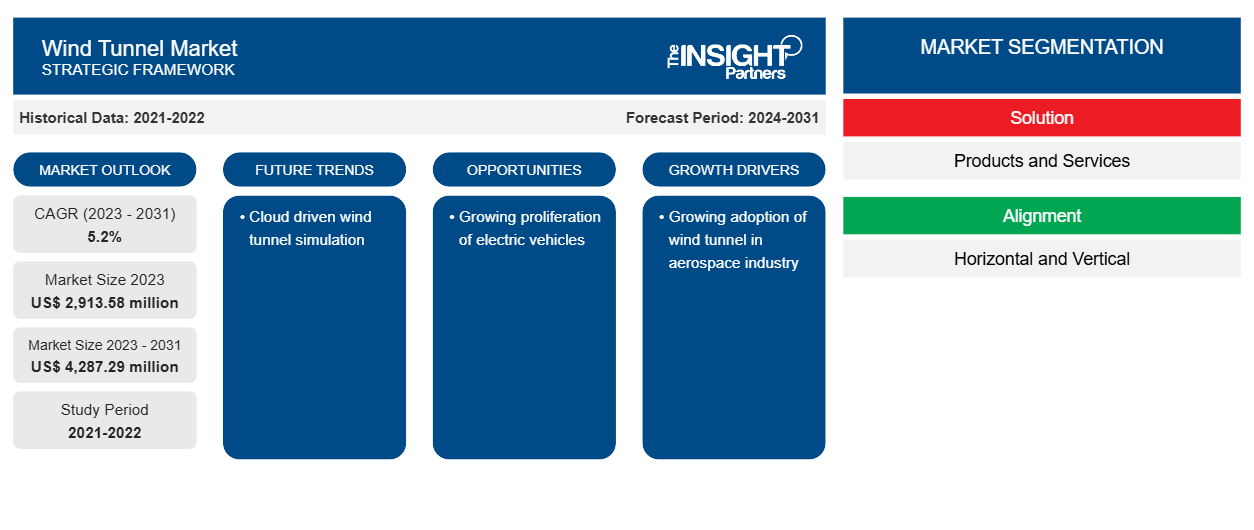La taille du marché des souffleries devrait atteindre 4 287,29 millions USD d'ici 2031, contre 2 913,58 millions USD en 2023. Le marché devrait enregistrer un TCAC de 5,2 % au cours de la période 2023-2031. Le développement croissant du secteur de la construction devrait rester une tendance clé du marché.
Analyse du marché des souffleries
Les investissements croissants des gouvernements pour renforcer les capacités de fabrication dans les pays en développement et les améliorations apportées aux services de maintenance, associés aux progrès de la technologie des installations d'essai, devraient stimuler la demande de souffleries parmi les industries utilisatrices finales dans les années à venir. Les utilisateurs finaux des souffleries sont des industries à grande échelle, telles que l'automobile et l'aérospatiale, qui influencent directement la dynamique du marché. Actuellement, le secteur des véhicules électriques dans l'automobile et les secteurs de la fabrication de drones et d'avions/missiles de défense dans l'aérospatiale stimulent la croissance du marché.
Aperçu du marché des souffleries
La demande croissante d'infrastructures vertes et l'adoption croissante des véhicules électriques devraient stimuler la demande pour le marché des souffleries à l'échelle mondiale. L'application croissante des souffleries dans le secteur aérospatial alimente la croissance du marché des souffleries à l'échelle mondiale. Des coûts élevés et des défis opérationnels sont associés au marché, ce qui pourrait entraver la croissance. Cependant, la prolifération croissante des simulations de souffleries pilotées par le cloud devrait orienter la croissance du marché des souffleries à l'échelle mondiale.
Personnalisez ce rapport en fonction de vos besoins
Vous bénéficierez d'une personnalisation gratuite de n'importe quel rapport, y compris de certaines parties de ce rapport, d'une analyse au niveau des pays, d'un pack de données Excel, ainsi que de superbes offres et réductions pour les start-ups et les universités.
-
Obtenez les principales tendances clés du marché de ce rapport.Cet échantillon GRATUIT comprendra une analyse de données, allant des tendances du marché aux estimations et prévisions.
Moteurs et opportunités du marché des souffleries
La prolifération croissante des bâtiments écologiques favorise le marché
L'accent croissant mis sur les approches respectueuses de l'environnement et durables dans le secteur de la construction devrait stimuler la croissance du marché des souffleries à l'échelle mondiale. La soufflerie peut identifier la vitesse du vent autour de la surface du bâtiment. L'impact de la force du vent sur le bâtiment est crucial, en particulier dans les immeubles de grande hauteur avec de grandes surfaces exposées au vent, où la structure interne du bâtiment résiste aux forces résultantes. Malgré l'adoption croissante de la dynamique des fluides computationnelle pour les tests structurels en raison d'un calcul plus rapide, elle n'est pas considérée comme adaptée à une utilisation courante dans la conception structurelle des bâtiments, car ses prédictions doivent être vérifiées par des expériences. L'évaluation de l'impact de la force du vent sur les immeubles de grande hauteur , les usines et les ponts peut aider les concepteurs de bâtiments à construire une structure qui résiste efficacement aux effets du vent. Par conséquent, la prolifération croissante du marché des bâtiments écologiques stimule la croissance du marché des souffleries.
Demande croissante de véhicules électriques
L'aérodynamique joue un rôle important dans les voitures électriques par rapport aux véhicules à moteur à combustion interne, car la plus grande utilisation d'énergie pour accélérer ou conduire en montée peut être récupérée grâce à la récupération d'énergie. Pour répondre aux besoins de récupération d'énergie, les ingénieurs automobiles effectuent une analyse aérodynamique d'une voiture de tourisme électrique à l'aide de souffleries. Les souffleries effectuent les principaux tests aérodynamiques d'un véhicule électrique. L'accent croissant mis sur la réduction de la pollution environnementale et la tendance croissante à l'adoption de véhicules de tourisme électriques devraient offrir des opportunités positives pour le marché des souffleries.
Analyse de segmentation du rapport sur le marché des souffleries
Les segments clés qui ont contribué à l’élaboration de l’analyse du marché des souffleries sont la solution, l’alignement,type de vitesse et application.
- En fonction de la solution, le marché des souffleries est divisé en produits et services. Le segment des services détenait une part de marché plus importante en 2023.
- Par alignement, le marché est segmenté en segment horizontal et vertical. Le segment horizontal détenait une part de marché plus importante en 2023.
- En termes de type de vitesse aérienne, le marché est divisé en subsonique, supersonique, transsonique et hypersonique. Le segment subsonique détenait une part importante du marché en 2023.
- En termes d'application, le marché est segmenté en aérospatiale et défense, automobile et transport, construction de bâtiments et énergie éolienne, formation et simulation, sports d'aventure, parachutisme, etc. Le segment aérospatial et défense détenait une part importante du marché en 2023.
Analyse des parts de marché des souffleries par zone géographique
La portée géographique du rapport sur le marché des souffleries est principalement divisée en cinq régions : Amérique du Nord, Asie-Pacifique, Europe, Moyen-Orient et Afrique, et Amérique du Sud et centrale.
L'Europe est leader du marché. L'application croissante des souffleries dans le secteur de l'aérospatiale et de la défense stimule la croissance du marché des souffleries en Europe. Il existe différents types de souffleries, chacune avec ses propres caractéristiques et sa propre plage de vitesse. Les centres de recherche et les laboratoires de construction et de conception d'avions exploitent largement les souffleries. En outre, l'application croissante des souffleries subsoniques dans le secteur aérospatial a également un impact positif sur la croissance du marché des souffleries dans la région. La forte présence de fournisseurs de produits et de services de soufflerie dans la région agit également comme un moteur majeur du marché des souffleries en Europe.
Aperçu régional du marché des souffleries
Les tendances régionales et les facteurs influençant le marché des souffleries tout au long de la période de prévision ont été expliqués en détail par les analystes d’Insight Partners. Cette section traite également des segments et de la géographie du marché des souffleries en Amérique du Nord, en Europe, en Asie-Pacifique, au Moyen-Orient et en Afrique, ainsi qu’en Amérique du Sud et en Amérique centrale.

- Obtenez les données régionales spécifiques au marché des souffleries
Portée du rapport sur le marché des souffleries
| Attribut de rapport | Détails |
|---|---|
| Taille du marché en 2023 | 2 913,58 millions USD |
| Taille du marché d'ici 2031 | 4 287,29 millions USD |
| Taux de croissance annuel composé mondial (2023-2031) | 5,2% |
| Données historiques | 2021-2022 |
| Période de prévision | 2024-2031 |
| Segments couverts |
Par Solution
|
| Régions et pays couverts |
Amérique du Nord
|
| Leaders du marché et profils d'entreprises clés |
|
Densité des acteurs du marché : comprendre son impact sur la dynamique des entreprises
Le marché des souffleries connaît une croissance rapide, tirée par la demande croissante des utilisateurs finaux en raison de facteurs tels que l'évolution des préférences des consommateurs, les avancées technologiques et une plus grande sensibilisation aux avantages du produit. À mesure que la demande augmente, les entreprises élargissent leurs offres, innovent pour répondre aux besoins des consommateurs et capitalisent sur les tendances émergentes, ce qui alimente davantage la croissance du marché.
La densité des acteurs du marché fait référence à la répartition des entreprises ou des sociétés opérant sur un marché ou un secteur particulier. Elle indique le nombre de concurrents (acteurs du marché) présents sur un marché donné par rapport à sa taille ou à sa valeur marchande totale.
Les principales entreprises opérant sur le marché des souffleries sont :
- Aérolab
- Aïolos
- La société Boeing
- ETW GmbH
- Horiba Ltée
- Société Lockheed Martin
Avis de non-responsabilité : les sociétés répertoriées ci-dessus ne sont pas classées dans un ordre particulier.

- Obtenez un aperçu des principaux acteurs du marché des souffleries
Actualités et développements récents du marché des souffleries
Le marché des souffleries est évalué en collectant des données qualitatives et quantitatives après des recherches primaires et secondaires, qui comprennent d'importantes publications d'entreprise, des données d'association et des bases de données. Quelques-uns des développements du marché des souffleries sont répertoriés ci-dessous :
- La soufflerie climatique MAHLE « passe à l'électrique ». MAHLE élargit la gamme de services de son installation ultramoderne de Stuttgart et permet de tester les effets de la charge rapide sur les batteries Li-ion sensibles dans une large gamme de conditions climatiques possibles. (Source : Groupe MAHLE, communiqué de presse, février 2023)
- L'Université de Notre Dame et Lockheed Martin Corporation ont signé un accord-cadre de recherche le 4 novembre 2021, afin de faciliter les collaborations futures qui font progresser la recherche aérospatiale. Cet accord témoigne de la volonté mutuelle des deux institutions d'accélérer leur relation productive en cours. (Source : Lockheed Martin Corporation, communiqué de presse, novembre 2021)
Rapport sur le marché des souffleries et livrables
Le rapport « Taille et prévisions du marché des souffleries (2021-2031) » fournit une analyse détaillée du marché couvrant les domaines ci-dessous :
- Taille et prévisions du marché des souffleries aux niveaux mondial, régional et national pour tous les segments de marché clés couverts par le périmètre
- Tendances du marché des souffleries ainsi que dynamique du marché telles que les facteurs moteurs, les contraintes et les opportunités clés
- Analyse PEST et SWOT détaillée
- Analyse du marché des souffleries couvrant les principales tendances du marché, le cadre mondial et régional, les principaux acteurs, les réglementations et les développements récents du marché
- Analyse du paysage industriel et de la concurrence couvrant la concentration du marché, l'analyse de la carte thermique, les principaux acteurs et les développements récents pour le marché des souffleries
- Profils d'entreprise détaillés
- Analyse historique (2 ans), année de base, prévision (7 ans) avec TCAC
- Analyse PEST et SWOT
- Taille du marché Valeur / Volume - Mondial, Régional, Pays
- Industrie et paysage concurrentiel
- Ensemble de données Excel
Rapports récents
Rapports connexes
Témoignages
Raison d'acheter
- Prise de décision éclairée
- Compréhension de la dynamique du marché
- Analyse concurrentielle
- Connaissances clients
- Prévisions de marché
- Atténuation des risques
- Planification stratégique
- Justification des investissements
- Identification des marchés émergents
- Amélioration des stratégies marketing
- Amélioration de l'efficacité opérationnelle
- Alignement sur les tendances réglementaires























 Obtenez un échantillon gratuit pour - Marché des souffleries
Obtenez un échantillon gratuit pour - Marché des souffleries